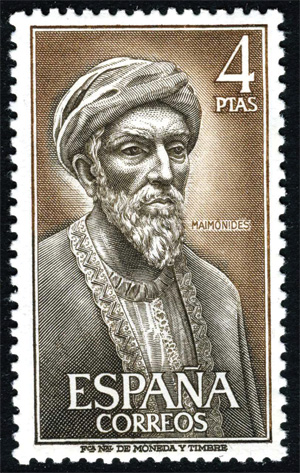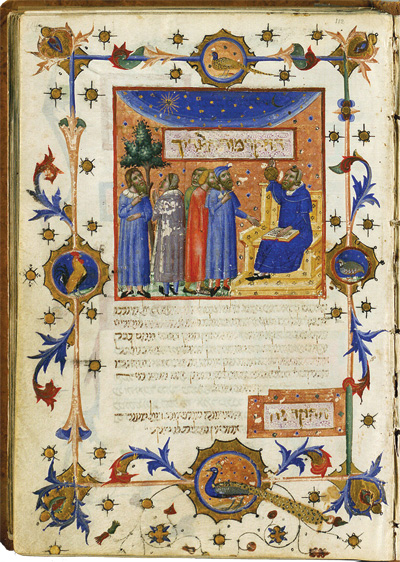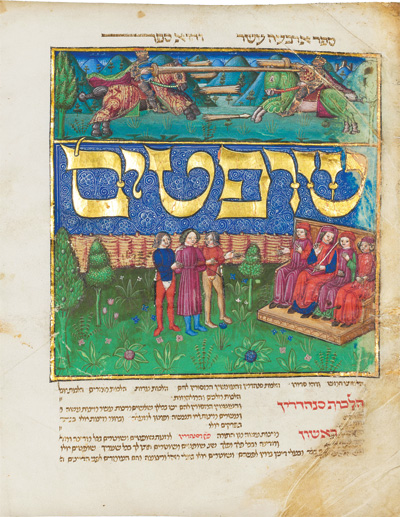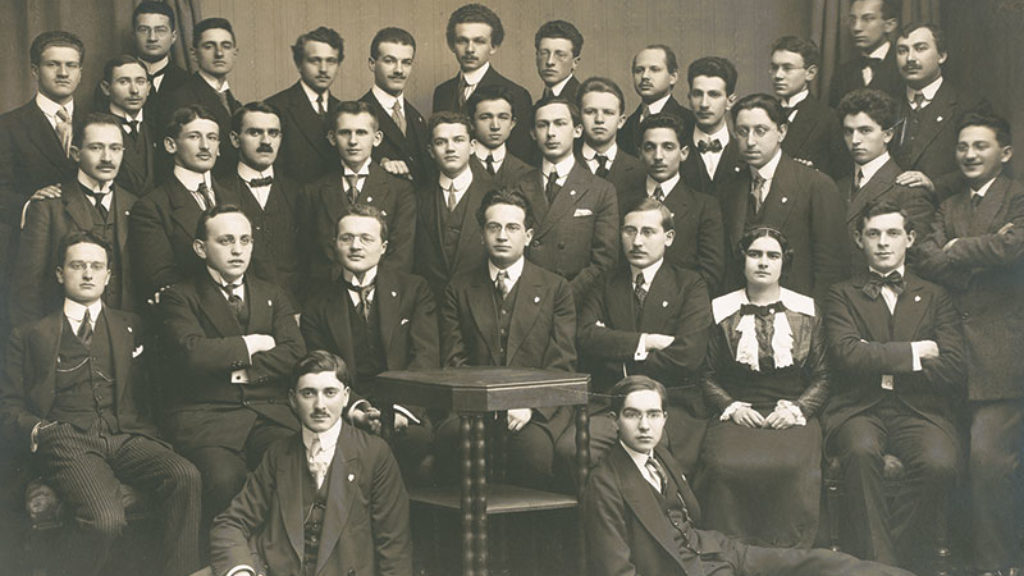Thoroughly Modern Maimonides?
Does Maimonides have anything to say to us today, and if so what? These questions have been raised once again by Moshe Halbertal’s brilliant new intellectual biography Maimonides: Life and Thought (published in Hebrew in 2009 and now available in English), as well as by two other recent major analyses of his philosophy, Josef Stern’s The Matter and Form of Maimonides’ Guide and Herbert Davidson’s Maimonides the Rationalist.
Maimonides, who was a great halakhist, authored three major works of Jewish law: the Commentary on the Mishnah and the Book of Commandments, and, towering above them, that summa of rabbinic Judaism, the greatest work of Jewish law authored by a single individual, the Mishneh Torah. He is also, of course, the author of the most important work of medieval Jewish philosophy, perhaps of all Jewish philosophy, The Guide of the Perplexed. While most rabbinic scholars focus on Maimonides the halakhist and most academics on Maimonides the philosopher, Halbertal is one of the very few scholars equipped to do justice to both sides of Maimonides’ creativity—and their interconnection. Indeed Maimonides: Life and Thought is one of only a handful of scholarly books on Maimonides to fully cover both the halakhic and the philosophical sides of Maimonides’ work.
At the very beginning and end of his book Halbertal sums up what he sees as the two great intellectual transformations Maimonides sought to achieve. In the realm of Jewish law, the Mishneh Torah was, Halbertal writes:
a mighty effort to extract the halakhah from the thicket of Talmudic discussions, marked by frequent disagreement and tangled debate. . . . Maimonides created an unambiguous, comprehensive, and exhaustive halakhic text . . . by omitting the . . . give and take, the disagreements, and the minority opinions that appear in earlier halakhic writings.
In the realm of philosophy, Maimonides first de-anthropomorphized God, stripping Him of all physical and psychological attributes, thereby “shifting the struggle against idolatry from the realm of external plastic representation to that of internal mental representation.” Second, he focused “on the causal order and the [divine] wisdom inherent in it as the most substantive revelation of the divinity.” Third, he erased “the distinction between what is within the Jewish tradition and what is external to it.” This is a characteristically lucid presentation, though I would add a fourth component to Maimonides’ attempted revolution: his unremitting struggle against all forms of superstition, magic, and theurgy.

Though Halbertal does not explicitly link the three components he sets out, clearly they are interconnected. Precisely because the divine wisdom inherent in nature is the most substantive revelation of the divinity, philosophy and science are the best means “for attaining the heights of religious experience—love and awe of God.” And the God whose wisdom is discerned in the natural order turns out to be, for Maimonides, a de-anthropomorphized, non-personalist God. I would add that Maimonides’ rejection of all forms of superstition, magic, and theurgy derives, in turn, from the view of God and the world set forth by science and philosophy. Maimonides’ God, whose wisdom is manifest in the causal order of nature, cannot be manipulated.
It is worth noting, however, that Halbertal sometimes says that according to Maimonides knowledge “makes it possible for [a person to love God] and the world.” But, in fact, Maimonides never speaks of love of the world. What one perceives as manifest in the natural and causal order is God’s wisdom, which leads to the love of God and God alone. In suggesting otherwise, it seems to me that Halbertal subtly but unmistakeably modernizes Maimonides.
As Halbertal indicates, Maimonides’ attempted transformation of the Jewish religious consciousness “required a new and comprehensive interpretation of the tradition,” and indeed he devoted his great work, the Guide, to this task. In doing so, he attempted to give “his spiritual and religious positions binding status.” Yet, Halbertal notes, “historically speaking [Maimonides] did not succeed in bringing about the change in religious consciousness that he hoped for,” and his metaphysically austere interpretation of Judaism has always been a minority position, albeit an important one. Perhaps one reason for Maimonides’ failure to effect a spiritual revolution is that, as Halbertal notes elsewhere, he also failed to have the Mishneh Torah accepted as the authoritative code of Jewish law.
Halbertal shows in detail how Maimonides “integrated his new religious sensibility into his code.” This is very well done, but does not break new ground. His chapters on the conceptual underpinnings of Maimonidean halakha do just that. The Mishneh Torah’s goal—Halbertal states in his chapter “What Is Mishneh Torah?”—was to make “the whole halakhah transparent and accessible.” Yet, Halbertal goes on to say, “Beneath this transparency, however, lies an intense ambiguity bearing on the nature of Mishneh Torah itself . . . and on the concept of authority that underlies it.” Thus, Halbertal asserts, there are moderate and radical ways of viewing Maimonides’ own understanding of the Mishneh Torah’s authority. According to the moderate understanding, the Mishneh Torah is “a broad, comprehensive representation of the halakhah.” According to the radical reading, it is not just “a representation of the law but the law itself.”

Halbertal proceeds to elaborate upon the differences resulting from these two understandings and shows that some statements of Maimonides support the moderate account and others the radical. But are these two accounts as mutually exclusive as Halbertal suggests? In the radical reading, Halbertal notes, the question arises as to the source of the Mishneh Torah’s authority. He points to the Introduction to the Mishneh Torah, where Maimonides maintains that the authority of the Babylonian Talmud derives from its having been “accepted by all Israel.” This view, Halbertal suggests, “lays the groundwork for the possibility of Mishneh Torah being transformed into a binding halakhic book in the event it, too, is accepted by all Israel.” But this begs the question as to why it would be accepted. Surely, because in the view of “all Israel” it constitutes “a broad, comprehensive representation of the halakhah.” Indeed, this may not be so far from Maimonides’ understanding as to how the Talmud became authoritative. For in his presentation of the history of halakha in his Introduction to his Commentary on the Mishnah Maimonides maintains—a point not noted by Halbertal—that the Talmud, to begin with, was accepted by “all Israel” because of its great wisdom.
One of the results of the radical understanding of the Mishneh Torah is that it would thereby “obviate all other halakhic literature and that all Israel will learn halakhah from it.” This leads us paradoxically to the most innovative and incisive chapter in Halbertal’s book, on Maimonides’ “conceptual understanding of halakhah.” In this chapter Halbertal examines in detail and with great acuity the Mishneh Torah’s often radical reorganization of rabbinic law, showing how this reorganization “reflects a conceptual understanding of halakhic principles.” Particularly convincing is Halbertal’s demonstration that Maimonides’ apparently problematic placement of the laws of mourning in Judges (Shoftim), which deals with public law, derives from his view that mourning is not so much a psychological process that helps the mourner overcome his loss but “is first and foremost a statement about the status and honor of the deceased . . . Mourning is a mechanism for constructing the basic social order, signifying the full membership and status of a person in the community.”
Not only does the Mishneh Torah reflect a powerful conceptual framework, its “rich, precise formulations” call for conceptual unpacking and analysis. But here the paradox arises. For the great 20th-century rabbinic practitioners of this analytic approach to the Mishneh Torah, Rabbis Chaim ha-Levi Soloveitchik, Meir Simcha ha-Kohen, and Yitzhak Ze’ev Soloveitchik, among others, used the Mishneh Torah, as Halbertal correctly notes, “to gain a better grasp of the underlying talmudic discussion and to develop a conceptual understanding of the halakhah.” Thus, despite Maimonides’ goal of the Mishneh Torah’s displacing the Talmud, its distinctive features have, paradoxically, led back to talmudic study.
The Guide of the Perplexed’s deliberately enigmatic, often opaque, unsystematic, and indeed explicitly secretive nature stands in stark opposition to the Mishneh Torah’s clarity. Moreover, Maimonides clearly distinguishes between the true opinions and the (socially or politically) necessary beliefs that the Torah teaches, not always making it clear as to which biblical views fall into which category. Not surprisingly, then, the work’s ambiguous legacy led very soon after its publication to divergent readings. Halbertal canvases four basic approaches—skeptical, mystical, conservative, and philosophical—without attempting to decide between them. Instead, in a brilliant tour de force he shows how a consideration of these four approaches allows him to examine all—or rather almost all—of the central issues treated in the Guide.
Halbertal uses the debate between the skeptical and mystical approaches to examine the first 70 chapters of Part I of the Guide, in which Maimonides launches a thoroughgoing critique of religious language. First, Maimonides de-anthropomorphizes biblical sensory terms applied to God, translating them into conceptual language. For example, God’s “eye” turns out to refer to God’s knowledge. Then, in Chapters 50–70, he tackles the meaning of those conceptual terms themselves. What do we mean when we refer to God’s knowledge (or existence or unity)? Maimonides’ answer is famously radical: We can have no positive knowledge about God. The skeptical reading understands this conclusion to mean that, though Maimonides never states this explicitly, no metaphysical knowledge about God can be attained. The mystical reading, on the other hand, while conceding to the skeptics that we cannot attain any knowledge about God expressible in language, affirms that we can, nonetheless, know God metalinguistically. As Halbertal puts it, after passing through “the refiner’s fire of philosophy,” we can transcend the limits of language and arrive at “a great illumination incapable of being formulated.”
Halbertal proceeds to use the debate between the conservative and philosophical readings of the Guide to examine all—or rather almost all—the rest of the philosophical issues discussed by Maimonides. First and foremost is “the work’s great and central metaphysical issue [which runs from Chapter 71 of Part I to Chapter 31 of Part II]: was the world created ex nihilo or has it existed for all eternity, like God?” Then follow four subjects dealt with in the second half of the Guide, each of which, Halbertal argues, depends on how one believes Maimonides answered the question of creation versus eternity. These four subjects are prophecy, the problem of evil, divine providence and knowledge, and the reasons for the commandments.

The conservative reading takes Maimonides at his word and views his great achievement as being the defense of creation as a reasonable possibility, indeed more probable than eternity, though neither is rationally demonstrable. The philosophic reading views Maimonides’ defense of creation as a necessary belief and maintains that esoterically he adhered to Aristotle’s teaching of eternal pre-existence. The Guide’s great achievement on this reading is “its affording the fundamental concepts of Judaism—creation, prophecy, providence, and commandment, among others—an interpretation consistent with the concept of an eternal world.”
The reason why creation versus eternity is the central metaphysical issue of the Guide, Halbertal explains, is that they entail two different conceptions of God. Creation entails a God of will, while eternity entails a God of wisdom. If God’s will gave rise to the world, then it can also, in principle, breach the order of nature established by it, allowing for His continuing involvement in the world. If, however, the natural order reflects His wisdom and has existed of necessity from eternity, then it cannot be breached. Yet, as Halbertal notes, the possibility of creation and consequently of God’s interventions in the world “does not negate the idea that nature, with the wisdom implicit in it, is the central, most substantive revelation of God in the world.” It follows, though Halbertal omits to mention this, that there is an asymmetry between the conservative and philosophical readings of the Guide on this central issue. In the philosophical reading, Maimonides basically did away with the concept of divine will; on the conservative reading, Maimonides, while stressing the idea of divine will, still left a central role for divine wisdom.
Strikingly, Halbertal never limns a rationalist reading of the Guide; indeed, he never refers to Maimonides’ rationalism at all. In lectures and interviews, he has indicated that this was a deliberate decision, as he wants to avoid suggesting too dry and formalistic a cast to his thought. In marked contrast, the distinguished Maimonidean scholar Herbert A. Davidson entitled his recent collection of essays Maimonides the Rationalist.
As I noted, Halbertal examines “all—or rather almost all—of the central issues treated in the Guide.” What does he leave out? Halbertal asserts that the central metaphysical issue of creation versus eternity runs from Chapter 71 of Part I to Chapter 31 of Part II, but this is highly misleading. For the first subjects discussed in these chapters are the proofs of the existence, unity, and incorporeality of God, only after which Maimonides discusses the issue of creation versus eternity. Either the world is created or eternal. If the world is created, one can prove the existence, unity, and incorporeality of God, and the same holds true if the world is eternal.
Unlike Halbertal, Davidson focuses on Maimonides’ proofs about God, since, as he correctly points out, Maimonides holds that the first two positive commandments require us to know that God exists and is one. Maimonides further holds that knowledge requires not merely probability attained through dialectical argument—that suffices only for rational belief—but certainty attained through demonstrative proof. Hence the only way one can properly fulfill these two commandments is through demonstrative proof. Precisely here we see the meshing in Maimonides of binding halakha and rigorous, formal philosophy. It is in this sense, Davidson maintains, that Maimonides is a rationalist. It appears, then, that Halbertal is able to avoid speaking of Maimonides’ rationalism only by not discussing the one critical section of the Guide best characterized by that term!
Of course, on the skeptical reading of the Guide even these proofs do not give us any knowledge about God, since Maimonides’ analysis of religious language leads to the conclusion that we cannot attain any metaphysical knowledge about God. This reading was first suggested by Shlomo Pines, one of the last century’s leading Maimonidean scholars. Pines hypothesized that a lost text of the great Arab philosopher al-Farabi, which ibn Bajja quoted as saying “that after death and demise there is no afterlife, that there is no happiness except political happiness, [and] that there is no existence except that which is perceived by the senses,” might have influenced Maimonides. He brought several literary hints from within the Guide to support his view (hints forcefully dismissed by Davidson, incidentally).
Josef Stern’s recent, very rich, and carefully argued work The Matter and Form of Maimonides’ Guide makes the strongest philosophical case yet for a version of the skeptical reading. I will focus on two of his key arguments. Maimonides certainly tells us that we cannot say anything positive about God. However, in his famous doctrine of negative attributes he also says that we can translate positive descriptions of God into negative ones (“God is one” becomes “God is not many” and so on), and this constitutes real knowledge. Skeptical readers, like Stern, argue that such a positive evaluation of negative attributes merely has the status of a “necessary belief.” In truth, Stern maintains, Maimonides is critical of negative attributes, and all statements to the contrary are carefully qualified.
Maimonides opens his discussion of negative attributes in Guide 1:58 with the statement “Know that the description of God . . . by means of negations is the correct description.” This seems clear enough, but Stern notes that Maimonides uses the term “correct,” not “true.” Stern continues, “One senses that they are ‘correct’ only relative to our other linguistic alternatives for talking about God.” But Stern is a careful writer and “one senses” is a tip-off that he is on shaky ground. Maimonides later states that “negative attributes conduct . . . the mind toward the uppermost reach that man may attain in the apprehension [of God].” Again Stern argues that “This endorsement is more qualified than first appears,” noting that in an earlier chapter (1:46) “the term for ‘conduct’ [. . . signifies] ‘guidance’ to belief that something exists as opposed to the kind of understanding of true reality that constitutes . . . scientific knowledge.” Stern, however, overlooks the immediately preceding chapter (1:57) in which Maimonides uses the term “conduct” in the context of “conducting the mind to the truth of the matter.”
If no one, as Stern argues, can achieve any metaphysical knowledge of God, what is “the uppermost reach that man may attain in the apprehension [of God]”? Stern notes that in the great climactic chapter of the Guide, 3:51, Maimonides singles out Moses as having reached such a high level of apprehension that
It is said of Him “and he was there with the Lord” (Ex. 34:28), putting questions and receiving answers . . . in that holy place.
Stern asks—surprisingly, in a lifetime of studying the Guide, I do not recall anyone posing this question before—what Maimonides could possibly have meant by Moses’ “putting questions and receiving answers.” He notes that Maimonides twice constructs imaginary dialogues, the first between a philosopher and an Islamic theologian regarding the lawfulness of nature and the second between himself and Aristotle regarding creation versus eternity, and he suggests it was this kind of open-ended, inconclusive discussion that Maimonides was describing. However, it is more likely that Maimonides is alluding to Guide 1:54, where he speaks of Moses’ “making requests of God and receiving answers from Him”—which is explicitly interpreted to suggest a progression to ever-higher levels of knowledge.
If we grant Stern’s skeptical conclusion that we can have no metaphysical knowledge of God, the question arises as to what the point of philosophical inquiry was for Maimonides. Pines drew the radical conclusion that Maimonides, like (at least allegedly) al-Farabi before him, abandoned the ideal of human intellectual perfection, maintaining (though only esoterically) that the highest perfection is all too human, that is civic, political, and moral. But this, as Davidson and Stern note, goes against the entire thrust of the Guide. Stern more conservatively suggests that
Maimonides did not surrender the ideal of intellectual perfection . . . [but] it may function as a regulative ideal . . . What is important is not only what is proven but the drawing up of the proofs . . . not winning the race . . . but the race or pursuit itself.
This suggestion is certainly highly appealing to the modern temper, but, to paraphrase Richard Bentley’s famous remark to Alexander Pope about his translation of The Iliad: It’s a pretty picture, but you must not call it Maimonides!
One key statement of Maimonides with which I would have liked to see Stern contend is this one (from Guide 2:47): “For only truth pleases God and only falsehood angers Him,” which implies that only truth, not the search for truth, is of value. This statement also tells against Halbertal’s provocative suggestion in his book’s conclusion that Maimonides himself allowed for all four readings of the Guide, a pluralistic suggestion that also appeals to the modern temper. As for the conservative and philosophical readings, are they so opposed? We must remember that the issue of creation versus eternity, unlike that of the existence and unity of God, is irresolvable. At best one option can be shown to be more probable than the other by weighing the pros and cons. Therefore, even if Maimonides genuinely believed that creation is more probable than eternity—and I see no good reason for asserting that he did not—he could not dismiss the eternity of the world as a possibility. It is for this reason, and not because he secretly adhered to eternity, that he reinterprets “the fundamental concepts of [Judaism] in a manner consistent with the concept of an eternal world.” It is here and only here, it seems to me, that we can speak of Maimonides’ pluralism.
As Davidson notes, Maimonides’ proofs of the existence, unity, and incorporeality of God, dependent as they are on obsolete medieval scientific premises, have “turned to sand.” Yet Maimonides’ method of dialectical argumentation, his scrupulous setting forth of the competing views on theological issues and weighing their pros and cons in the absence of certain knowledge, which constitutes the bulk of the Guide, still has much to teach us. When Josie Ashkenazi, the protagonist of Dara Horn’s recent boldly titled novel, A Guide for the Perplexed, is kidnapped in Cairo and held captive by Muslim terrorists with only a French translation of the Guide for a companion, she becomes absorbed by Maimonides’ dialectical discussion of the various opinions on divine providence. I doubt if his proofs for God’s existence would have similarly held her attention.
Here, perhaps, we arrive at the final irony: It was just this kind of non-demonstrative, give-and-take argument, and its concomitant ethic of preserving minority opinions, that Maimonides tried to eradicate in halakha with the Mishneh Torah! Moshe Halbertal shows how rabbinic scholars used the Mishneh Torah against its intentions “to gain a better grasp of the underlying Talmudic discussion,” carefully weighing its views against those of other medieval rabbinic authorities. No doubt, the Maimonides of the Mishneh Torah would have been dismayed to learn how his great code has been (mis)used. But perhaps the Maimonides of the Guide, with its more rabbinic sensibility, would have smiled and conceded the rightness of such an approach.
Editor’s Note: Click to read Josef Stern’s reply and Lawrence Kaplan’s rejoinder to this essay.
Suggested Reading

Bambi’s Jewish Roots
Felix Salten was a hack who cultivated ties to the Habsburg court and wrote the bestselling memoir of a fictional prostitute. He was also a charismatic Zionist who outshone Buber on the stage and—not so coincidentally—wrote Bambi
Letters, Fall 2023
A Question of Authority It’s inaccurate and fundamentally unfair to take the words of a character in a novel and attribute them to the author. Sadly, this is what Nadia Kalman elects to do in her review of my novel, The Dissident (“Problems with Authority,” Summer 2023). Writes Kalman: This novel seems to be saying something like this: antisemitic persecutions…

From the Great War to the Cold War
The facts of Hans Kohn’s life are so extraordinary that it almost seems as if the first half of one remarkable figure’s biography had been spliced together with another’s in the second part.
Oh Homeland, Don’t You Wonder (Tzion Ha-lo Tishali)
Dan Alter translates Judah Halevi's poem of yearning for Zion from nearly a thousand years ago.
Comments
You must log in to comment Log In